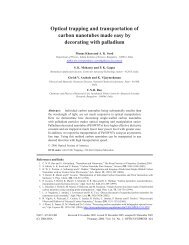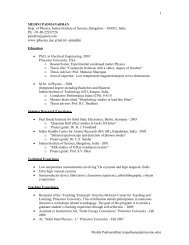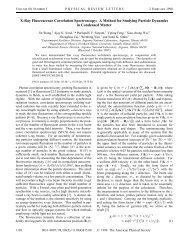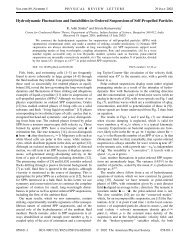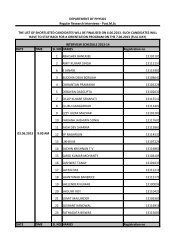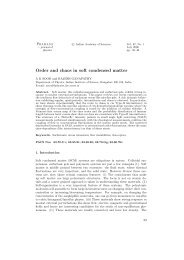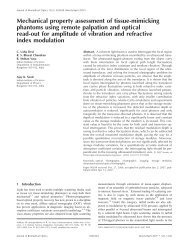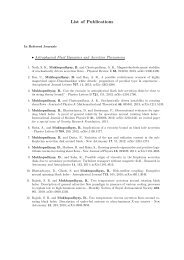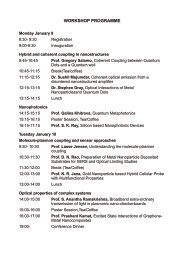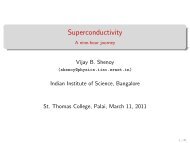Curriculum Vitae - Physics
Curriculum Vitae - Physics
Curriculum Vitae - Physics
You also want an ePaper? Increase the reach of your titles
YUMPU automatically turns print PDFs into web optimized ePapers that Google loves.
<strong>Curriculum</strong> <strong>Vitae</strong><br />
Smarajit Karmakar<br />
Contact Information :<br />
Department of Chemical <strong>Physics</strong><br />
The Weizmann Institute of Science<br />
Rehovot 76100<br />
Israel<br />
E-mail :smarajit.karmakar@weizmann.ac.il<br />
Personal Information :<br />
Permanent add : Kalikapur, Bolpur,<br />
Birbhum, West Bengal 731204, India,<br />
Ph. No. +913463252746<br />
Date of Birth: January 22, 1980.<br />
Sex : Male<br />
Nationality : INDIAN<br />
Educational Qualifications :<br />
Secondary Examination ( 1996)<br />
West Bengal Board of Secondary Education<br />
Marks Obtained : 88%<br />
Higher Secondary Examination ( 1996 - 1998)<br />
West Bengal Council of Higher Secondary Education<br />
Marks Obtained : 85%<br />
Bachelor of Science, (<strong>Physics</strong> Major) ( 1998 - 2001)<br />
Department of <strong>Physics</strong><br />
Siksha Bhavana, Visva Bharati University.<br />
Santiniketan, India.<br />
Marks Obtained : 83%<br />
Master of Science, (<strong>Physics</strong>) ( 2001 - 2004)<br />
Centre for Condensed Matter Theory,<br />
Department of <strong>Physics</strong>, Indian Institute of Science.<br />
Bangalore, India<br />
MS Thesis : Liquid to Solid Transition for Hard Sphere<br />
Systems : Density Functional Theory<br />
Thesis Advisor : Prof. Chandan Dasgupta<br />
CGPA :: 7.2 (8.0)<br />
PhD ( 2004 - 2009)<br />
Centre for Condensed Matter Theory,<br />
Department of <strong>Physics</strong>, Indian Institute of Science.<br />
Bangalore 560 012, India.<br />
PhD Thesis : Numerical Studies of Slow Dynamics and Glass<br />
Transition in Model Liquids<br />
Thesis Advisor : Prof. Chandan Dasgupta<br />
Computational Skill :<br />
• Programming Language :: F77, F90, C, Shell Script<br />
• Parallel Programming :: OpenMP, MPI<br />
• System Administration :: Handling Linux Clusters
References<br />
Prof. Chandan Dasgupta<br />
Department of <strong>Physics</strong><br />
Indian Institute of Science<br />
Bangalore - 560012, INDIA<br />
Phone: +91 (80) 2293 3278, 2360 3924<br />
Email: cdgupta@physics.iisc.ernet.in<br />
URL: http://www.physics.iisc.ernet.in/~cdgupta<br />
Prof. Sriram Ramaswamy<br />
Department of <strong>Physics</strong><br />
Indian Institute of Science<br />
Bangalore - 560012, INDIA<br />
Phone: +91 (80) 2293 3283 or 2360 2698<br />
Email: sriram@physics.iisc.ernet.in<br />
URL: http://www.physics.iisc.ernet.in/~sriram<br />
Prof. Srikanth Sastry<br />
Theoretical Sciences Unit<br />
Jawaharlal Nehru Centre for Advanced<br />
Scientific Research<br />
Jakkur Campus<br />
Bangalore - 560064, INDIA<br />
Phone: +91 80 2208 2838/2750<br />
Fax: +91 80 2208 2767/2766<br />
Email: sastry@jncasr.ac.in<br />
URL: http://www.jncasr.ac.in/sastry<br />
Prof. Itamar Procaccia<br />
Department of Chemical <strong>Physics</strong><br />
The Weizmann Institute of Science<br />
Rehovot 76100<br />
Israel<br />
e-mail: Itamar.Procaccia@weizmann.ac.il<br />
Dept. FAX: ++972 (8) 934-4123<br />
Voice: ++972 (8) 934-3918 ( Dept. secretary)<br />
++972 (8) 934-4051 (Office)<br />
URL: http://www.weizmann.ac.il/chemphys/cfprocac/<br />
List of Publications :<br />
1. Equilibrium Glassy Phase in a Polydisperse Hard-Sphere System - Pinaki Chaudhuri,<br />
Smarajit Karmakar, Chandan Dasgupta, H.R. Krishnamurthy, and A.K.Sood - Phys. Rev.<br />
Lett. 95, 248301 (2005).<br />
2. Signatures of Dynamical Heterogeneity in the Structure of Glassy Free-energy Minima -<br />
Pinaki Chaudhuri, Smarajit Karmakar and Chandan Dasgupta, Phys. Rev. Lett. 100,<br />
125701 (2008).<br />
3. Growing length and time scales in glass forming liquids - Smarajit Karmakar, Chandan<br />
Dasgupta, and Srikanth Sastry, Proc. Nat. Acad. Sci. (USA) 106, 3675 (2009).<br />
4. Size of Plastic Events in Strained Amorphous Solids at Finite Temperatures - H.G.E.<br />
Hentschel, Smarajit Karmakar, Edan Lerner, Itamar Procaccia, Phys. Rev. Lett., 104,<br />
025501 (2010).<br />
5. Predicting plastic flow events in athermal shear-strained amorphous solids - Smarajit<br />
Karmakar, Anael Lemaitre, Edan Lerner and Itamar Procaccia, Phys. Rev. Lett., 104,<br />
215502 (2010).<br />
6. Analysis of dynamic heterogeneity in a glass former from the spatial correlations of<br />
mobility - Smarajit Karmakar, Chandan Dasgupta, Srikanth Sastry, Phys. Rev. Lett. 105,<br />
015701 (2010).<br />
7. Comment on “Scaling Analysis of Dynamic ..... Liquid” by Stein and Andersen - Smarajit<br />
Karmakar, Chandan Dasgupta, Srikanth Sastry, Phys. Rev. Lett. 105, 019801 (2010).<br />
8. Plasticity-Induced Anisotropy in Amorphous Solids: the Bauschinger Effect - Smarajit<br />
Karmakar, Edan Lerner, Itamar Procaccia, arXiv:0910.4281 (will appear in Phys. Rev. E. ).
9. Athermal Nonlinear Elastic Constants of Amorphous Solids - Smarajit Karmakar, Edan<br />
Lerner, and Itamar Procaccia, arXiv: 1004.2198 ( will appear in Phys. Rev. E ) .<br />
10. Time Scales in the Theory of Elasto-Plasticity of Amorphous Solids - Laurent Boue, Peter<br />
Harrowell, Smarajit Karmakar, Edan Lerner, Itamar Procaccia, Ido Regev, Jacques Zylberg<br />
- arXiv:0911.4646 (submitted to Euro. Phys. Lett. ).<br />
11. Statistical <strong>Physics</strong> of Elasto-Plastic Steady States in Amorphous Solids: Finite<br />
Temperatures and Strain Rates - Smarajit Karmakar, Edan Lerner, Itamar Procaccia,<br />
Jacques Zylberg – arXiv:1006.3737 ( submitted to Phys. Rev. E ).<br />
12. Finite Size Scaling Analysis of beta-relaxation regime and its connection to dynamic<br />
heterogeneity in a glass former - Smarajit Karmakar, Sumilan Banerjee, Pranabjyoti<br />
Bhuyan, Chandan Dasgupta, and Srikanth Sastry (manuscript under preparation) .<br />
13. Finite Size Scaling Analysis of Four-point Susceptibility of Glass-forming Kob-Anderson<br />
Binary Mixture - Smarajit Karmakar, Chandan Dasgupta, Srikanth Sastry (manuscript<br />
under preparation).<br />
14. Finite Size Scaling Analysis of Kob-Anderson Binary Mixture in 2D - Shiladitya Sengupta,<br />
Smarajit Karmakar, Chandan Dasgupta, Srikanth Sastry (manuscript under preparation).<br />
Prizes:<br />
• Top Rank in Bachelor of Science and Master of Science<br />
• Kumari L. A. Meera Memorial Award for the year 2003 − 2004 in recognition of being the<br />
best Integrated PhD Student in Physical Sciences, IISc, Bangalore, India.<br />
• National Eligibility Test (NET) – 2004<br />
• Recipient of Prestigious Dean's Fellowship, Weizmann Institute of Science – 2010 -<br />
2012.<br />
Schools and Conferences Attended :<br />
• SERC School on Statistical <strong>Physics</strong> - TIFR, Mumbai, INDIA, 16 th to 28 th February 2004<br />
• Conference and School on UNIFYING CONCEPTS IN GLASS PHYSICS III STATPHYS -<br />
22nd Satellite Meeting<br />
School :: 25-26 June 2004, Conference: 28 th June - 1 st July 2004<br />
Jawaharlal Nehru Centre for Advanced Scientific Research, Bangalore<br />
• STATPHYS22 - 22nd International Conference on Statistical <strong>Physics</strong> - IISc, Bangalore,<br />
INDIA July 4 th to 9 th , 2004<br />
• Advanced Graduate School in Statistical and Condensed Matter <strong>Physics</strong> - Dept. of<br />
<strong>Physics</strong>, IISc Bangalore, INDIA, January to April 2005<br />
• School on Understanding Molecular Simulations - Centre for Computational Materials<br />
Science, Jawaharlal Nehru Centre for Advanced Scientific Research, Bangalore 560064, INDIA<br />
22 nd to 27 th January, 2007
• Dynamical heterogeneities in glasses, colloids and granular media<br />
Lorentz Center of Leiden University, Leiden, The Netherlands<br />
August 31 th until September 6 th , 2008<br />
• School on Glass Formers and Glasses - Jawaharlal Nehru Centre for Advanced Scientific<br />
Research, Bangalore, India, 4 th to 20 th January, 2010.<br />
• COST Strategic Workshop on "<strong>Physics</strong> of Amorphous Solids:Mechanical Properties and<br />
Plasticity" on 14 th to 19 th March 2010, in Les Houches (France).<br />
Research Experience :<br />
• Density Functional Theory : liquid to crystal transition and glass<br />
transition in simple liquids<br />
we have applied density functional theory to study phase transitions in different hard sphere systems. We<br />
have studied hard sphere systems as the model liquid and the free energy of the system is calculated using<br />
the Ramkrishnan-Yussouff free energy functional. We have minimized the free energy variationally to locate<br />
the crystalline and glassy local minima. We showed that the width of the local peaks of the time-averaged<br />
density field at a glassy free-energy minimum exhibits large spatial variation, similar to that of the “local<br />
Debye-Waller factor” in simulations of dynamical heterogeneity. Molecular dynamics simulations starting<br />
from a particle configuration generated from the density distribution at a glassy free-energy minimum show<br />
similar spatial heterogeneity in the degree of localization, implying a direct connection between dynamical<br />
heterogeneity and the structure of glassy free energy minima. Results have been communicated in<br />
our second paper. We have also studied the freezing transition of polydisperse hard sphere systems. We<br />
have found that the freezing into a crystalline state is not possible beyond a critical polydispersity. The<br />
calculated critical polydispersity turns out to be s ~ 0.05, which is qualitatively in agreement with<br />
experimental findings. We have also found a reentrant transition in the polydisperse hard sphere system.<br />
For a given value of the polydispersity, the system first freezes into a crystalline phase as the density is<br />
increased, but if the density is increased further, crystalline phase become unstable and the system goes<br />
through another transition to a phase which we believe is glassy. This result has been already published in<br />
PRL. In this study, I have used the liquid state theory to calculate the direct correlation functions and<br />
implemented the Lubachevsky-Stillinger algorithm to generate dense random packing for hard sphere<br />
systems; these have been used as initial configurations for the free energy minimization of the glassy state.<br />
This variational minimization has been done for a very large number (~ 2500) of variables to map out the<br />
detailed density distribution of the glassy free energy minimum<br />
• Finite Size Scaling for the Glass Transition<br />
We have used finite size scaling analysis, similar to that used on studies of critical phenomena near<br />
continuous phase transition, to extract a growing correlation length in glassy system. Finite size scaling is<br />
an universally accepted method in critical phenomena for extracting the underlying correlation length. Our<br />
analysis is based on the finite-size behaviour of a four-point dynamical susceptibility 4(t). We found that<br />
although the peak height of 4(t) shows normal finite-size scaling behaviour, the dependence of relaxation<br />
time on the system size is not consistent with it. We have shown that the unusual behaviour of relaxation<br />
time as function of system size can be explained using the Adam-Gibbs relation. Thus our study indicates<br />
that the energy landscape of the super cooled liquid has a strong influence on the dynamics even above the<br />
Mode Coupling temperature. The correlation length, extracted from the scaling analysis, indeed grows with<br />
decreasing temperature, but it doesn’t exhibit the power law divergence at the Mode Coupling temperature<br />
predicted by the Mode Coupling theory. Our data can be better interpreted by the Random First Order<br />
Transition Theory or the Mosaic Theory, which describes the glass transition as an entropically driven<br />
transition relating configurational entropy with dynamics. We are checking the validity of different aspect of<br />
this mosaic theory by doing intensive molecular dynamics simulation for a wide range of temperature and in<br />
different dimensions. In this study, I have done intensive molecular dynamics simulation and also<br />
parallelized the code using MPI library to do some large system size simulation. In configurational entropy<br />
calculation, thermodynamic integration method has been used to calculate the bulk entropy. Inherent<br />
structures have been obtained by doing conjugate gradient minimization from which we have extracted the<br />
basin entropy by diagonalising the Hessian matrix. The difference of bulk entropy and basin entropy is
defined as the configurational entropy.<br />
• Mechanical Properties of Amorphous Solids<br />
Linear elasticity in amorphous systems is a relatively well-understood problem, questions like how does<br />
the disorder influence the approximations to elastic constants and what are the required corrections to the<br />
Born-Huang theory have been dealt with thoroughly in the past. On the other hand, plasticity in amorphous<br />
solids is very poorly understood. In crystalline materials it is generally accepted that the microstructural<br />
objects which govern deformation and flow are a class of topological defects known as dislocations. Most<br />
work in the field of crystalline plasticity focuses on describing deformation in terms of the underlying<br />
dislocation dynamics. In the case of noncrystalline systems the situation is not so clear, even though a broad<br />
category of systems - including metallic glasses, clays and soils, pastes, foams, gels, and other so-called<br />
'soft'' materials' -- seem to share remarkable similarities. In the past several decades much work regarding<br />
the underlying microscopic processes of amorphous plastic flow, has left many unanswered questions and<br />
much controversy. Perhaps the most important of these questions is whether or not there exist some sort of<br />
microstructural defects in the materials which, roughly speaking, play the role of the dislocations in<br />
crystals. There are some recent phenomenological theories which tried to address these questions, Shear<br />
Transformation Zone theory of Langer et al is by far the most impressive theory among them. But there also<br />
its not very clear what controls the plastic yielding. The order parameter proposed in that theory is<br />
extremely difficult to calculate if not impossible. In our recent studies on mechanical properties of<br />
amorphous solids we proposed an order parameter which can in some sense be equivalent to the order<br />
parameter proposed in the STZ theory. But a complete theory is still lacking. We also tried to find out<br />
whether one can predict the plastic failure based on the linear and non-linear elasticity at some strain value.<br />
We found out that one can in principle predict the plastic failure if one has enough information about few<br />
higher order non-linear elastic coefficients.



